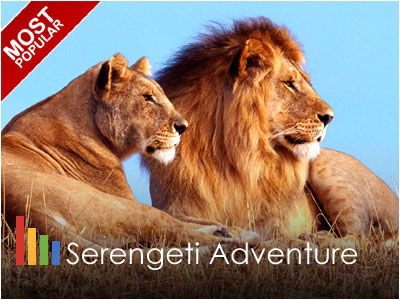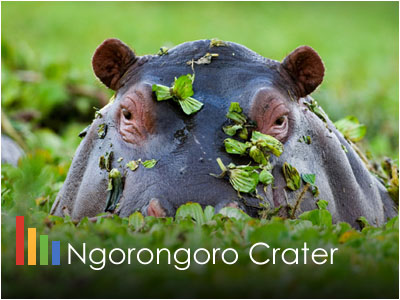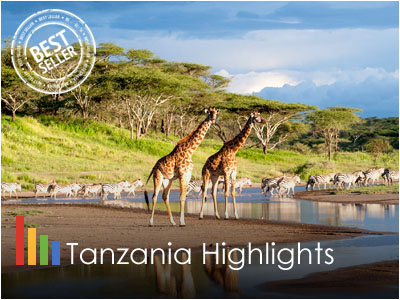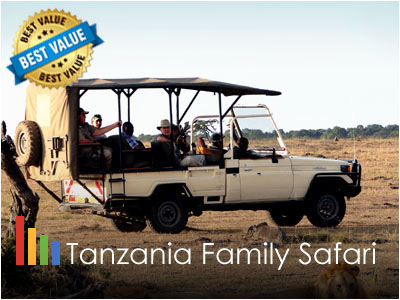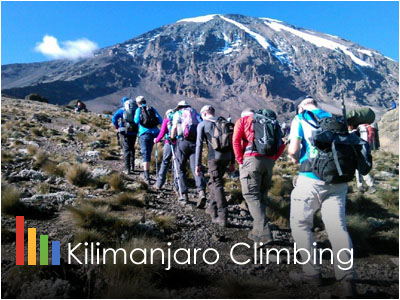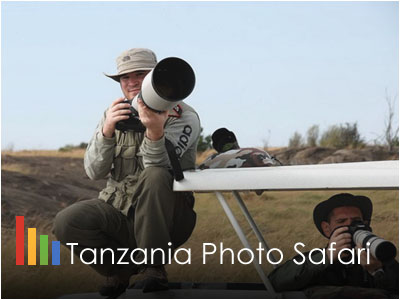Mount Kilimanjaro, Tanzania, Africa
Mount Kilimanjaro - Tanzania, Africa
Mount Kilimanjaro is located withing Mount Kilimanjaro National Park. Kilimanjaro is a Maasai word meaning Large Rock. Kilimanjaro is 340 km south of the Equator, 280 km from the Indian Ocean and just over 400 km from Lake Victoria. It is about one hour’s drive from Kilimanjaro airport. It lies on the eastern side of the eastern branch of the Great Rift Valley, and north-north east of the Maasai steppe, the great plain of north-eastern Tanzania renowned as the homeland of the nomadic Maasai cattle-herders. Kilimanjaro has three volcanic cones, Kibo, Mawensi, and Shira, and is an inactive stratovolcano in north-eastern Tanzania. Although it does not have the highest elevation, Kilimanjaro is the tallest free-standing mountain rise in the world, rising 4,600 m (15,100 ft) from its base, and includes the highest peak in Africa at 5,895 meters (19,340 ft), providing a dramatic view from the surrounding plains.

Basic Facts - Mount Kilimanjaro National Park
Mount Kilimanjaro National Park boasts a broad variety of landscapes, ranging from open savannah through acacia scrubland to rainforest and, eventually, to alpine conditions on the higher reaches of Mt. Meru. Mount Kilimanjaro National Park is the home to Mount Meru (4,566 m), breathtaking landscapes ranging from the Meru Crater in the west, the Ngurdoto Crater in the south-east to the grasslands and of course the alkaline Momella lakes in the north-east. This park is often overlooked by visitors, worried they will not see that much wildlife. However Mount Kilimanjaro National Park has such a lot to offer and dazzles with a perfect mix of flora and fauna and diversified landscapes. Passing the “small Serengeti” during a game drive, you are likely to spot peaceful herds of buffaloes, shy bushbucks on the edge of the forest as well as warthogs and zebras. Heading towards the Ngurdoto Crater you will soon find yourself in a lush rainforest – a great place to spot the athletic black and white colobus monkey as well as the elegant mitis monkey. The Ngurdoto Crater is basically a smaller version of the Ngorongoro Crater and has a diameter of about 3 km. With a bit of luck you might even spot buffaloes in the swamps on the crater floor.
More About Mount Kilimanjaro
Kilimanjaro is located in Tanzania near the border of Kenya south of the equator. Kilimanjaro is the highest mountain in Africa and tallest freestanding mountain in the world, rising 15,100 feet (4600 meters from base to summit). Kilimanjaro is composed of three distinct volcanic cones. Ibo 19,340 feet, mawenzi 16,867 feet and Shira 13000 feet, Uhuru peak is the highest summit on kibo’s crater rim. Kilimanjaro is a giant strato volcano that began forming a million years ago when the lava spilled from the rift valley zone. The mountain was formed by successive lava flows. Two of its three peaks mawenzi and shira are extinct while Kibo, the highest peak is dormant and could erupt again. The major eruption occurred 360,000 years ago, while the most recent activity was only 200 years ago. Kilimanjaro has 2.2 sq kilometers of glacial ice and is losing it quickly due to global warming. The glaciers have shrunk 82% since 1912 and declined 33% since 1989. It may be ice free 20 years which will dramatically local drinking water, crop irrigation and hydroelectric power. The mountain lies within 756 sq km, a UNESCO world heritage site and is one of the few places on earth that encompasses of ecological life zone including tropical jungle, savannah, desert to montane forests, subalphine plants and the alpine zone above timberline.
The name 'Kilimanjaro' itself is a mystery wreathed in clouds. It might mean Mountain of Light, Mountain of Greatness or Mountain of Caravans. The local people, the Wachagga, don't even have a name for the whole massif, only Kipoo (now known as Kibo) for the familiar snowy peak that stands imperious, overseer of the continent, the summit of Africa. Kilimanjaro, by any name, is a metaphor for the compelling beauty of East Africa. It is located at the north/eastern tip of Tanzania. Not only is Kilimanjaro the highest peak on the African continent; it is also the tallest free-standing mountain in the world, rising in breathtaking isolation from the surrounding coastal scrubland – elevation around 900 metres – to an imperious 5,895 metres (19,336 feet). Kilimanjaro is one of the world's most accessible high summits, a beacon for visitors from around the world. Most climbers reach the crater rim with little more than a walking stick, proper clothing and determination. And those who reach Uhuru Point, the actual summit, or Gillman's Point on the lip of the crater, will have earned their climbing certificates. This is your chance to get to the roof of Africa! For the adventurous, a climb of Mt. Kilimanjaro is a must taking you through the mists of equatorial jungle to reach the snows and breath-taking views from the summit.
One of the most amazing aspects of the mountain in the present day is the accessibility of its peak to climbers with no mountain climbing equipment or real previous experience of scaling such heights. Kilimanjaro is the highest mountain that regular tourists can climb, although it remains a considerable feat of human endurance! The breathable oxygen at the top is less than half the amount than is common at sea level, and climbers cover at least eighty kilometres on nothing but their own two feet over the five days it takes to reach the top and return. The one-way Machame Route climbs up the southwest of the mountain. This is a more challenging, but less frequented trail than the busier Marangu Route and offers more of a wilderness experience. Kilimanjaro climbers should be fit and well exercised.
Machame and Lemosho routes are popular and scenic.marangu is the easiest and busy although the last a scent to the crater rim is difficult. Climbing Kilimanjaro is easy and requires no technical climbing or mountaineering experience. With the exception of the summit zone, wildlife is potentially encountered throughout the lower parts of the climb. Animals existing in this area include: elephants, buffalo, eland on the northern slopes, black and white colobus monkeys,skyes monkeys and birds such as sunbirds, augur buzzard ,mountain hawk eagle lammergeyer and white napped ravens. Covered in mist most of the day Mount Kilimanjaro is the most tourist attractive site in Tanzania, pulling in thousands and thousands of tourists each year. Kilimanjaro houses over 140 species of mammals, 179 species of birds and at least 7 larger mammal species above the tree line.
The best months for the climb are July to September (cold but dry) and January to mid-March (clearer and warmer). While thousands of people scramble to the top of Kilimanjaro each year, there are also trails off the beaten track and some technical climbs for the experienced mountaineer. There are five principal trails up the mountain: Marangu, Mweka, Umbwe, Shira and Machame. These are all hiking routes. The most popular route is the Marangu route. It takes about five days and involves walking about 85 kilometres.. For more information regarding tours and safaris to Mount Kilimanjaro National Park, please DO NOT hesitate to Contact Us.
First Stage: Tropical Forest
With most of the old lowland forest now cultivated and settled, the first experience of the mountain environment begins with the dense vegetation of tropical montane forest between 1850m and around 2800m. Cloud condensation mainly gathers around the forest, so this area is usually damp or drenched with rainfall, creating an intriguing mass of plant life and running rivers between endemic tree species. The area of heath just beyond the tree line also enjoys a relatively misty and damp environment as cloud clings around the density of trees. This is covered with heather and shrubs such as Erica Arborea and Stoebe Kilimandsharica, and a number of dramatic looking Proteas.
Second Stage: Open Moorland
From around 3,200m a wide expanse of moorland extends beyond the heath and the cloud line, so that here the skies are generally clear, making the sunshine intense during the days and the nights cool and clear. The climbing incline remains gentle, but thinning oxygen provides less fuel to energise the muscles and can dramatically slow the pace of walking. Hardy endemic species of Giant Groundsels (Senecio) and Lobelia (Deckenii) towering up to 4m high thrive in this moorland zone and give the landscape a strangely primeval atmosphere.
Third Stage: Alpine Desert, Sparse Vegetation
Even higher, beyond 4,000m, this sensation intensifies as the landscape develops into a more bizarre alpine desert, with sandy loose earth and intense weather conditions and temperature fluctuations so dramatic that barely any plant species survive other than everlasting flowers, mosses and lichens. Only the odd lichen survives beyond 5000m, after Kibo Huts and beyond the Saddle, where the landscape is predominantly rock and ice fields. Here, climbers experience the final steep push to the summit.
Final Stage: Saddle to Summit
The easterly routes, Marangu, Mweka, Loitokitok and Rongai all converge west of the saddle near Gillmans Point, between the peaks of Mawenzi and Kibo. Kibos crater is roughly circular with an inner cone extending to 5,800m, (100m lower than the summit at Uhuru Peak). At the centre an inner crater with walls between 12 and 20 m high contains another concentric minor cone, the centre of which falls away into the 360m span of the ash pit. This is the 120 metre deep central core of the volcano, and casts sulphurous boiling smoke from its depths despite the frozen, snowy outskirts.
Although it is possible to simply trek a route to the pinnacle of Kibo without relying on professional climbing equipment, it remains a hard and serious endeavour that requires a level of physical fitness, stamina and a realistic awareness of the potentially damaging effects of high altitudes. AfriChoice recommends that clients consult a doctor before attempting to scale the mountain, and have a physical check-up for overall fitness. NB: For more information regarding Mount Kilimanjaro National Park, DO NOT hesitate to Contact Us.
AfriChoice operates a wide range of carefully designed tours and safaris to Mount Kilimanjaro National Park by providing transport and booking a hotel for you. Having gone all the way to climb Kilimanjaro, most climbers choose to extend their trip with a Tanzanian safari or even some beach time in Zanzibar or on the mainland coast. It is the perfect way to round off the African holiday of a lifetime. Our safari consultants will always be at your assistance should you need a tailor-made holiday to this unique destination. NB: For more information regarding Mount Kilimanjaro National Park, DO NOT hesitate to Contact Us.
Contact Us for more information:
Tanzania Popular Wildlife Safaris
-
Serengeti Safari Adventure
Serengeti 3 Days Safari
-
Ngorongoro Crater Tour
Ngorongoro Crater Safari
-
Tanzania Highlights Safari
Tanzania Wildlife Safari
-
Best of Tanzania Safari
Best of Tanzania Safari
-
Tanzania Family Safari
Tanzania Family Safari
-
Mt. Kilimanjaro Climb
Mount Kilimanjaro Tanzania
-
Tanzania Photo Safari
Tanzania Wildlife Photo Safari
-
Tanzania Safari & Zanzibar
Tanzania Safari & Zanzibar Beach



 Paul Kitching - UK
Paul Kitching - UK Karen Howard - CANADA
Karen Howard - CANADA


